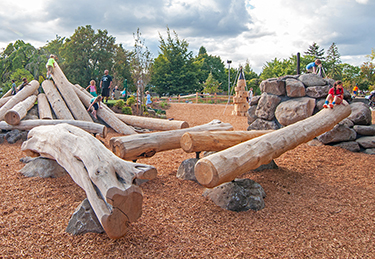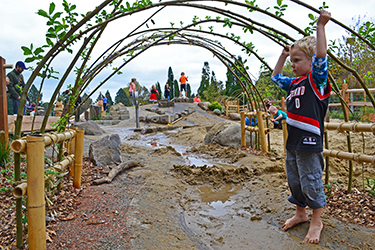|
Subscribe / Renew |
|
|
Contact Us |
|
| ► Subscribe to our Free Weekly Newsletter | |
| home | Welcome, sign in or click here to subscribe. | login |
Environment
| |
October 28, 2014
GreenWorks creates new kind of adventure playground for Portland
Portland has a new kind of play area in Westmoreland Park, with places for children to play in sand and water, climb on boulders and logs, and use large sequoia branches to build forts.
The Portland landscape architecture firm GreenWorks worked with Portland Parks & Recreation to replace an outdated playground and create a pilot project for similar play spaces.
Mike Faha of GreenWorks said in a press release that the project provides play opportunities that are different from traditional parks and playgrounds.
Environmental artist Adam Kuby was part of the design team and worked on the conceptual design as well as artistic elements and play features.
PP&R Director Mike Abbate said part of the goal is to connect children and families to environmental stewardship. Interpretive markers tell the story of restoring Crystal Springs Creek, which runs through the park and was an inspiration for the design team.
“Children are innately fascinated by nature,” Abbate said. “We are proud to offer a natural play area that creates opportunities for children to explore, discover, take challenges and risks, and learn. These are the types of play which are essential to healthy development.”
Here are some of the park's features:
• A concrete stream channel with willow tunnels, water pumps, recycled concrete weirs and sand
• Boulder scrambles and tilted logs arranged for play, with varying degrees of difficulty so children of different ages can use them
• Sculptures for climbing made of salvaged log segments
• Building frames with “loose parts” such as branches children can use for making forts and tents
• A grove of sequoia trees
• Grassy mounds for sitting and picnics
• Benches made of salvaged logs
Faha of GreenWorks said this kind of play encourages creativity, problem solving, social development and cooperation as well as improving balance and strength, and is especially important for children in an urban setting.
Working with Kuby, the design team developed spaces that metaphorically follow the path of rainwater from the Cascades forests through the aquifer and into the newly restored creek. Faha said the story is told in six carved basalt columns along a pathway that leads to the creek channel.
“We have seen the interest in nature-play growing, but it's hard for park providers to go ‘all-in' and build one like Westmoreland without really knowing what they are getting into,” he said. “The fear or inability for increased maintenance, the fear of risk and litigation, and the not knowing how to build are all some of the reasons why you don't see more nature play areas being built to the scale of Westmoreland.”
“From a landscape architect's perspective, this was one of the hardest projects I've ever worked on,” he said. “The custom detailing of each play element took more time than any of us anticipated. In the end it was worth the time investment to see how successful the play area is and how much we learned that we can apply to future projects.”
Part of the goal was to let others see what's possible. Faha said he thinks more play areas like this will be built in the next few years.
“It may feel like the beginnings of a design trend,” he said, “but the outcome and benefits will give nature-play staying power.”




